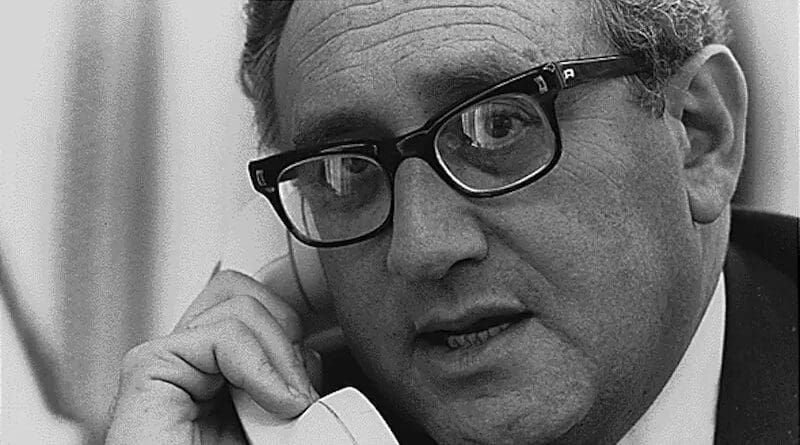C Raja Mohan

Henry Kissinger, the best-known American diplomat of modern times, is deeply associated in the Indian mind with the tumultuous events of 1971 – Pakistan Army’s brutal crackdown on the people of East Pakistan, the intensification of the secessionist movement there and India’s military intervention that helped create Bangladesh. Kissinger’s tilt to Pakistan and his insensitivity to the suffering of the Bengali population in East Pakistan have been widely portrayed as a reflection of his amoral and unacceptable foreign policy. In the world of Kissinger’s realpolitik, though, protecting an important Cold War ally – Pakistan – was driven by a deep consideration for the United States’ (US) interests in the 1970s. This included Pakistan’s valuable support in reaching out to China and preventing the South Asian crisis from escalating into a war between the superpowers – the US and the Soviet Union.
Less discussed within the Indian foreign policy community, which has never forgotten Kissinger’s role in 1971, is the fact that the US did not fire a single shot against India during the 1971 war. Nor did Washington affect the outcome of the Bangladesh war. During early December 1971, it did not take long for Kissinger and US President Richard Nixon to recognise that there was little chance of preserving Pakistan’s unity and had to give up. The US had to satisfy itself that its actions prevented India from dismembering West Pakistan.
The US’ tilt to Pakistan and the change in the US-China policy in 1971 altered the structure of South Asia’s regional and international relations. The breakup of Pakistan profoundly altered the balance of power irrevocably in favour of India. Although Delhi could not take full geopolitical advantage of Pakistan’s division in the last decades of the 20th century, India’s economic rise in the 21st century, its deepening cooperation with Bangladesh and improved ties with the West have rapidly elevated India’s standing with Pakistan.
If rearranging the great power relations with China and Russia is widely viewed as one of the main accomplishments of Kissinger’s foreign policy, it is seen as a negative legacy for the Indian foreign policy community. Many Indian diplomats view Kissinger as the one man responsible for facilitating the rise of China by drawing it into a long-term partnership with the US against the Soviet Union. Given the manifold challenges that China presents India today, this sentiment is understandable. It is easy to forget, however, that India championed China’s cause in Asia and the world at a time when the US was trying to isolate Beijing in the 1950s.
As Kissinger reached out to China in 1971, India was making a strategic manoeuvre move of its own. Within a month after Kissinger’s secret visit to China in July 1971, India signed a peace and security treaty with the Soviet Union. The reset in US-China relations was followed quickly by the elevation of Delhi’s ties with Moscow into an alliance-like relationship. The deepening US-China ties in the 1970s and 1980s were matched by a consolidation of India’s military and strategic relations with the Soviet Union. The period also saw the steady expansion of Pakistan-China relations and bouts of intense strategic cooperation between Washington and Islamabad. This structure of the regional balance of power survived until the end of the Cold War and the collapse of the Soviet Union during 1989-91.
India’s world, shaped by Kissinger’s moves in 1971, is now receding into history, and a new correlation of forces is emerging. We now have a robust India-US partnership no longer tied to Pakistan and aimed at securing an Asia that an assertive China has destabilised. After the Cold War ended in 1991 and Delhi embarked on economic reforms, Kissinger became an ardent supporter of the US-India partnership. After India’s nuclear tests in 1998, Kissinger was among the first to urge Washington to recognise the reality of an atomic India and find a political accommodation with Delhi by putting aside the non-proliferation ideology.
Amidst the deepening confrontation between Washington and Beijing and the deteriorating Sino-Indian relations since the second decade of the 21st century, the Narendra Modi government has moved India closer to the US than ever before. Delhi, which turned to Moscow to balance Beijing in the 1960s, now finds Russia increasingly in the Chinese corner and a less valuable strategic partner.
Taking a broader view, the scholar-statesman Kissinger was more perceptive than his Western compatriots in assessing India’s prospects in the 21st century. In 2014, Kissinger suggested that “India will be a fulcrum of twenty-first-century order: an indispensable element, based on its geography, resources, and tradition of sophisticated leadership, in the strategic and ideological equation of the region and of the global order at whose interaction it stands.” In an interview earlier this year, Kissinger said India’s foreign policy under Modi comes closest to his statecraft based on realpolitik.
Kissinger’s high praise for India underlines the transformation of Delhi’s foreign policy from an ideology to pragmatism. That transition, which began with then Indian Prime Minister Indira Gandhi’s 1971 tilt to the Soviet Union in response to the Sino-US entente, has culminated in the Modi government’s new strategic warmth to the US. Although the Indian foreign policy elites continue to denounce Kissinger’s role in 1971, their practice of the diplomatic craft today has become much like that of Kissinger. As the Economic Times reminded Indians, Kissinger should be “remembered by Kissingerians without emotion”.
No comments:
Post a Comment